#
THE PRESIDENT: Fellow citizens: For eight years, it has been my honor to serve as your President. The first decade of this new century has been a period of consequence — a time set apart. Tonight, with a thankful heart, I have asked for a final opportunity to share some thoughts on the journey that we have traveled together, and the future of our nation.
Five days from now, the world will witness the vitality of American democracy. In a tradition dating back to our founding, the presidency will pass to a successor chosen by you, the American people. Standing on the steps of the Capitol will be a man whose history reflects the enduring promise of our land. This is a moment of hope and pride for our whole nation. And I join all Americans in offering best wishes to President-Elect Obama, his wife Michelle, and their two beautiful girls.
Tonight I am filled with gratitude — to Vice President Cheney and members of my administration; to Laura, who brought joy to this house and love to my life; to our wonderful daughters, Barbara and Jenna; to my parents, whose examples have provided strength for a lifetime. And above all, I thank the American people for the trust you have given me. I thank you for the prayers that have lifted my spirits. And I thank you for the countless acts of courage, generosity, and grace that I have witnessed these past eight years.
This evening, my thoughts return to the first night I addressed you from this house — September the 11th, 2001. That morning, terrorists took nearly 3,000 lives in the worst attack on America since Pearl Harbor. I remember standing in the rubble of the World Trade Center three days later, surrounded by rescuers who had been working around the clock. I remember talking to brave souls who charged through smoke-filled corridors at the Pentagon, and to husbands and wives whose loved ones became heroes aboard Flight 93. I remember Arlene Howard, who gave me her fallen son’s police shield as a reminder of all that was lost. And I still carry his badge.
As the years passed, most Americans were able to return to life much as it had been before 9/11. But I never did. Every morning, I received a briefing on the threats to our nation. I vowed to do everything in my power to keep us safe.
Over the past seven years, a new Department of Homeland Security has been created. The military, the intelligence community, and the FBI have been transformed. Our nation is equipped with new tools to monitor the terrorists’ movements, freeze their finances, and break up their plots. And with strong allies at our side, we have taken the fight to the terrorists and those who support them. Afghanistan has gone from a nation where the Taliban harbored al Qaeda and stoned women in the streets to a young democracy that is fighting terror and encouraging girls to go to school. Iraq has gone from a brutal dictatorship and a sworn enemy of America to an Arab democracy at the heart of the Middle East and a friend of the United States.
There is legitimate debate about many of these decisions. But there can be little debate about the results. America has gone more than seven years without another terrorist attack on our soil. This is a tribute to those who toil night and day to keep us safe — law enforcement officers, intelligence analysts, homeland security and diplomatic personnel, and the men and women of the United States Armed Forces.
Our nation is blessed to have citizens who volunteer to defend us in this time of danger. I have cherished meeting these selfless patriots and their families. And America owes you a debt of gratitude. And to all our men and women in uniform listening tonight: There has been no higher honor than serving as your Commander-in-Chief.
The battles waged by our troops are part of a broader struggle between two dramatically different systems. Under one, a small band of fanatics demands total obedience to an oppressive ideology, condemns women to subservience, and marks unbelievers for murder. The other system is based on the conviction that freedom is the universal gift of Almighty God, and that liberty and justice light the path to peace.
This is the belief that gave birth to our nation. And in the long run, advancing this belief is the only practical way to protect our citizens. When people live in freedom, they do not willingly choose leaders who pursue campaigns of terror. When people have hope in the future, they will not cede their lives to violence and extremism. So around the world, America is promoting human liberty, human rights, and human dignity. We’re standing with dissidents and young democracies, providing AIDS medicine to dying patients — to bring dying patients back to life, and sparing mothers and babies from malaria. And this great republic born alone in liberty is leading the world toward a new age when freedom belongs to all nations.
For eight years, we’ve also strived to expand opportunity and hope here at home. Across our country, students are rising to meet higher standards in public schools. A new Medicare prescription drug benefit is bringing peace of mind to seniors and the disabled. Every taxpayer pays lower income taxes. The addicted and suffering are finding new hope through faith-based programs. Vulnerable human life is better protected. Funding for our veterans has nearly doubled. America’s air and water and lands are measurably cleaner. And the federal bench includes wise new members like Justice Sam Alito and Chief Justice John Roberts.
When challenges to our prosperity emerged, we rose to meet them. Facing the prospect of a financial collapse, we took decisive measures to safeguard our economy. These are very tough times for hardworking families, but the toll would be far worse if we had not acted. All Americans are in this together. And together, with determination and hard work, we will restore our economy to the path of growth. We will show the world once again the resilience of America’s free enterprise system.
Like all who have held this office before me, I have experienced setbacks. There are things I would do differently if given the chance. Yet I’ve always acted with the best interests of our country in mind. I have followed my conscience and done what I thought was right. You may not agree with some of the tough decisions I have made. But I hope you can agree that I was willing to make the tough decisions.
The decades ahead will bring more hard choices for our country, and there are some guiding principles that should shape our course.
While our nation is safer than it was seven years ago, the gravest threat to our people remains another terrorist attack. Our enemies are patient, and determined to strike again. America did nothing to seek or deserve this conflict. But we have been given solemn responsibilities, and we must meet them. We must resist complacency. We must keep our resolve. And we must never let down our guard.
At the same time, we must continue to engage the world with confidence and clear purpose. In the face of threats from abroad, it can be tempting to seek comfort by turning inward. But we must reject isolationism and its companion, protectionism. Retreating behind our borders would only invite danger. In the 21st century, security and prosperity at home depend on the expansion of liberty abroad. If America does not lead the cause of freedom, that cause will not be led.
As we address these challenges — and others we cannot foresee tonight — America must maintain our moral clarity. I’ve often spoken to you about good and evil, and this has made some uncomfortable. But good and evil are present in this world, and between the two of them there can be no compromise. Murdering the innocent to advance an ideology is wrong every time, everywhere. Freeing people from oppression and despair is eternally right. This nation must continue to speak out for justice and truth. We must always be willing to act in their defense — and to advance the cause of peace.
President Thomas Jefferson once wrote, “I like the dreams of the future better than the history of the past.” As I leave the house he occupied two centuries ago, I share that optimism. America is a young country, full of vitality, constantly growing and renewing itself. And even in the toughest times, we lift our eyes to the broad horizon ahead.
I have confidence in the promise of America because I know the character of our people. This is a nation that inspires immigrants to risk everything for the dream of freedom. This is a nation where citizens show calm in times of danger, and compassion in the face of suffering. We see examples of America’s character all around us. And Laura and I have invited some of them to join us in the White House this evening.
We see America’s character in Dr. Tony Recasner, a principal who opened a new charter school from the ruins of Hurricane Katrina. We see it in Julio Medina, a former inmate who leads a faith-based program to help prisoners returning to society. We’ve seen it in Staff Sergeant Aubrey McDade, who charged into an ambush in Iraq and rescued three of his fellow Marines.
We see America’s character in Bill Krissoff — a surgeon from California. His son, Nathan — a Marine — gave his life in Iraq. When I met Dr. Krissoff and his family, he delivered some surprising news: He told me he wanted to join the Navy Medical Corps in honor of his son. This good man was 60 years old — 18 years above the age limit. But his petition for a waiver was granted, and for the past year he has trained in battlefield medicine. Lieutenant Commander Krissoff could not be here tonight, because he will soon deploy to Iraq, where he will help save America’s wounded warriors — and uphold the legacy of his fallen son.
In citizens like these, we see the best of our country - resilient and hopeful, caring and strong. These virtues give me an unshakable faith in America. We have faced danger and trial, and there’s more ahead. But with the courage of our people and confidence in our ideals, this great nation will never tire, never falter, and never fail.
It has been the privilege of a lifetime to serve as your President. There have been good days and tough days. But every day I have been inspired by the greatness of our country, and uplifted by the goodness of our people. I have been blessed to represent this nation we love. And I will always be honored to carry a title that means more to me than any other - citizen of the United States of America.
And so, my fellow Americans, for the final time: Good night. May God bless this house and our next President. And may God bless you and our wonderful country. Thank you. (Applause.)
2009.1.15 8:14 P.M. EST
今天在公司测试SourceView3.0发现程序,找出所有支持SNMP的设备以及它们的链路,
包括服务器到交换机的链路:
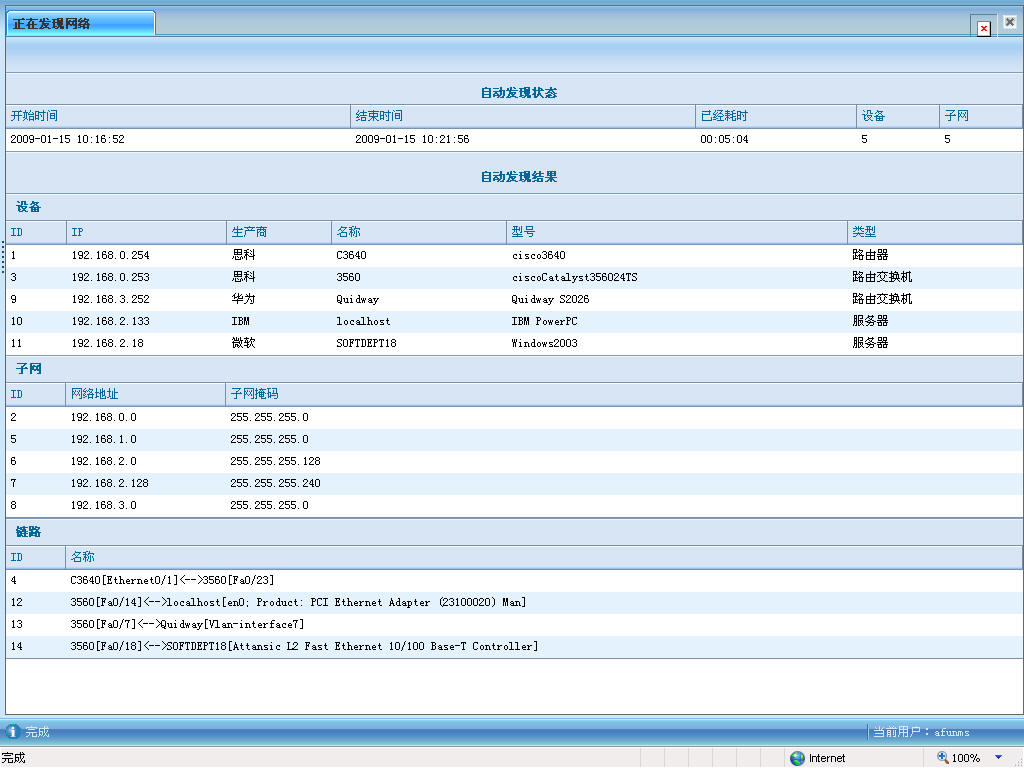 Discovery log:
Discovery log:
2009-01-15 14:09:44 - INFO - ----[SourceView3.0]Starting ----
2009-01-15 14:09:45 - INFO - Parsing configuration file [struts-default.xml]
2009-01-15 14:09:45 - INFO - Parsing configuration file [struts-plugin.xml]
2009-01-15 14:09:45 - INFO - Parsing configuration file [struts.xml]
2009-01-15 14:09:45 - INFO - Overriding property struts.i18n.reload - old value: false new value: true
2009-01-15 14:10:45 - INFO - 新主机加入:
1.路由器:ip=192.168.0.254,
sysOid=1.3.6.1.4.1.9.1.110,
sysName=C3640,
community=cisco,
symbol=cisco
---------------------
2009-01-15 14:10:46 - INFO - 新子网加入:
Subnet.2.addr[192.168.0.0],mask[255.255.255.0]
2009-01-15 14:10:56 - INFO - 新主机加入:
3.路由交换机:ip=192.168.0.253,
sysOid=1.3.6.1.4.1.9.1.633,
sysName=3560,
community=cisco,
mac=00:19:55:d9:9c:80,
symbol=cisco
---------------------
2009-01-15 14:10:57 - INFO - 新链路加入:
4.C3640[Ethernet0/1]<-->3560[Fa0/23],[route link](路由器到三层交换机)
2009-01-15 14:10:57 - INFO - 新子网加入:
Subnet.5.addr[192.168.1.0],mask[255.255.255.0]
2009-01-15 14:10:57 - INFO - 新子网加入:
Subnet.6.addr[192.168.2.0],mask[255.255.255.128]
2009-01-15 14:10:57 - INFO - 新子网加入:
Subnet.7.addr[192.168.2.128],mask[255.255.255.240]
2009-01-15 14:10:57 - INFO - 新子网加入:
Subnet.8.addr[192.168.3.0],mask[255.255.255.0]
2009-01-15 14:10:57 - INFO - 新子网加入:
Subnet.9.addr[192.168.4.0],mask[255.255.255.0]
2009-01-15 14:10:57 - INFO - 新子网加入:
Subnet.10.addr[192.168.5.0],mask[255.255.255.0]
2009-01-15 14:10:57 - INFO - 新子网加入:
Subnet.11.addr[192.168.6.0],mask[255.255.255.0]
2009-01-15 14:12:08 - INFO - 新主机加入:
12.路由交换机:ip=192.168.3.252,
sysOid=1.3.6.1.4.1.2011.2.23.22,
sysName=Quidway,
community=cisco,
mac=00:e0:fc:0c:9d:1b,
symbol=huawei
---------------------
2009-01-15 14:12:58 - INFO - 新主机加入:
13.服务器:ip=192.168.2.133,
sysOid=1.3.6.1.4.1.2.3.1.2.1.1.3,
sysName=localhost,
community=public,
symbol=aix
---------------------
2009-01-15 14:15:18 - INFO - 新主机加入:
14.服务器:ip=192.168.2.18,
sysOid=1.3.6.1.4.1.311.1.1.3.1.2,
sysName=SOFTDEPT18,
community=public,
symbol=windows
---------------------
2009-01-15 14:15:58 - INFO - ----discovering Layer 2 using the common method----
2009-01-15 14:15:58 - INFO - 新链路加入:
15.3560[Fa0/14]<-->localhost[en0; Product: PCI Ethernet Adapter (23100020) Man],[arp link](服务器到三层交换机)
2009-01-15 14:15:58 - INFO - find link from switch to the router or server:
0.null,[arp link]
2009-01-15 14:15:58 - INFO - find link from switch to the router or server:
0.null,[arp link]
2009-01-15 14:15:58 - INFO - find link from switch to the router or server:
0.null,[arp link]
2009-01-15 14:15:58 - INFO - find link from switch to the router or server:
0.null,[arp link]
2009-01-15 14:15:58 - INFO - find link from switch to the router or server:
15.3560[Fa0/14]<-->localhost[en0; Product: PCI Ethernet Adapter (23100020) Man],[arp link]
2009-01-15 14:15:58 - INFO - find link from switch to the router or server:
0.null,[arp link]
2009-01-15 14:15:58 - INFO - 新链路加入:
16.3560[Fa0/18]<-->SOFTDEPT18[Attansic L2 Fast Ethernet 10/100 Base-T Controller],[arp link] (服务器到三层交换机)
2009-01-15 14:15:58 - INFO - find link from switch to the router or server:
16.3560[Fa0/18]<-->SOFTDEPT18[Attansic L2 Fast Ethernet 10/100 Base-T Controller],[arp link]
2009-01-15 14:15:58 - INFO - 新链路加入:
17.3560[Fa0/7]<-->Quidway[Vlan-interface7],[arp link] (交换机到三层交换机)
2009-01-15 14:15:58 - INFO - find link from switch to the router or server:
0.null,[arp link]
2009-01-15 14:15:58 - INFO - find link from switch to the router or server:
0.null,[arp link]
2009-01-15 14:15:59 - INFO - ========全部发现完成了========
 完成用户手册,标志我们的软件向产品化、标准化又迈进了一步。
完成用户手册,标志我们的软件向产品化、标准化又迈进了一步。
希望2009年能把3.0做得更好。
背景:
用户环境比较简单,三台路由器和一台交换机。
问题总结:
1.长时间开着拓扑图,内存只增不减;
2.要一直开着IE才能及时看到报警,3.0准备开发一个windows客户端;
3.Tomcat使用了8080端口与Oracle使用的HTTP服务器端口冲突;
4.添加链路时,如果有一个接口是VLAN的,会有出错。

宝宝三个月,终于会爬了。

背景:
用户环境比较简单,一台路由器、3台windows2003服务器和一个Tomcat。
问题总结:
1.报表的数据存贮结构设计不好,导致程序复杂,容易出bug,而出了bug也不容易调试;
2.在这种相对简单的网络环境中,拓扑再发现还是很有用的,在3.0要实现这个功能;
3.应该支持在轮询时的发现,而不是要手动更改配置文件,这个在3.0中要改进;
4.报警配置经过上次的修改,现在已经比较好了,这是进步。

opennms的发现流程,基本看明白了:
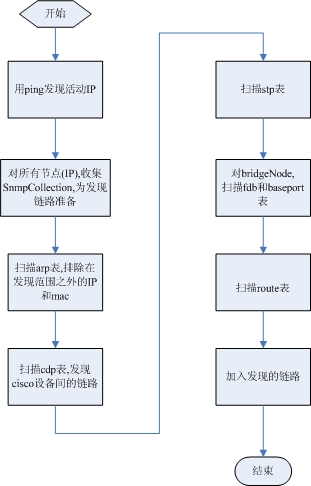
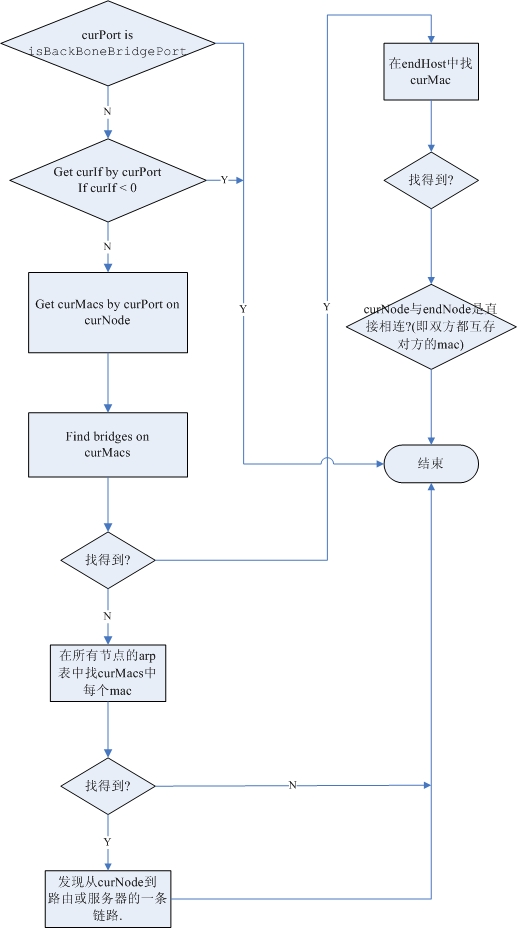
基于fdb表的发现,是二层发现最关键的部分。opennms这部分写得很好,给我很多启发。
另,1) 对backBoneBirdgePort的判定:对已经确定有链路的port为backBoneBirdgePort
2) 对bridgeIdentifier的判定:bridgeMac和fdb表中status=4的为bridgeIdentifier
很可惜,没看明白opennms关于stp发现这块。我觉得没这么复杂吧?
还好,我自己也能把基于STP的发现做出来。
opennms 对CDP表的探测流程:
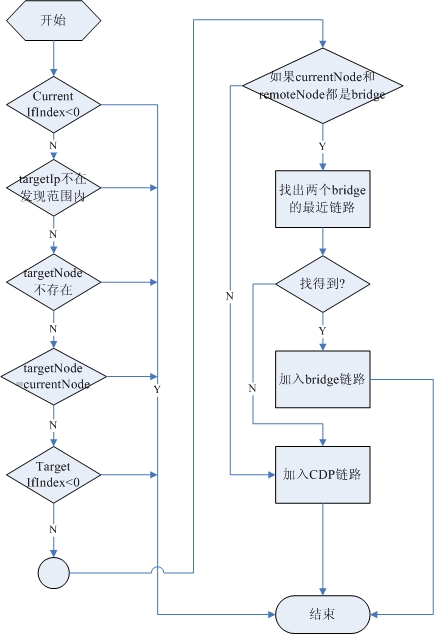
opennms对链路的发现全部在
DiscoveryLink这个类里。由于opennms对节点的发现没有确定节点
的设备类型,导致发现链路更加复杂。
opennms拓扑发现模块中,对路由表的探测流程如下:
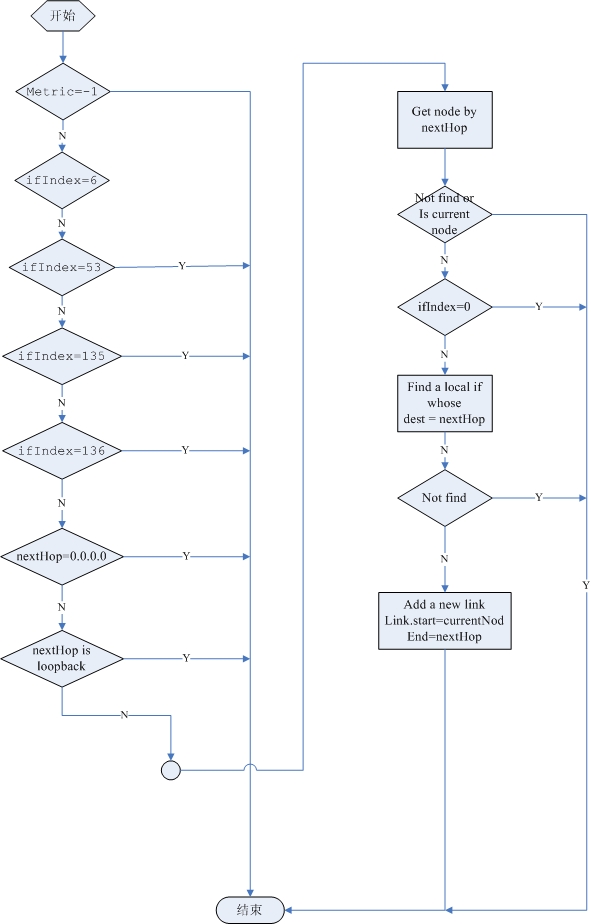
背景:
客户的WebSphere经常出问题,部署网管主要用于WebSphere的监控。
问题总结:
1. 对中间件的监控做得还不够细,可能我们以前的重点都放在对设备的监控。
2. 对中间件的监控可能对中间件性能造成影响,是否考虑改变监控方式?
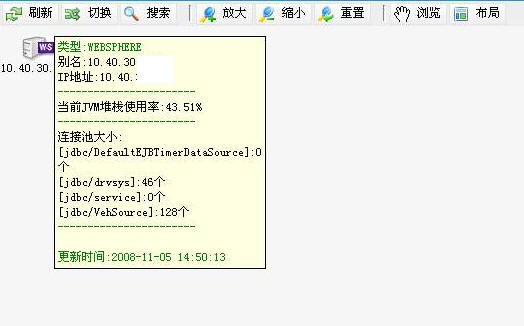
2008.10.30 女儿满月

http://www.oracle.com/technology/global/cn/pub/articles/hunter_meta.html
了解如何使用 J2SE 5.0 中提供的元数据批注
最新的 J2SE 5.0 版本(也以代号 "Tiger" 著称)为 Java 语言引进了许多变化,这些变化旨在使 Java 编程更有表现力、更加开发人员友好和更安全。我在 2003 年 9 月的一篇题目为“Java 即将发生巨大变化”的文章中介绍了许多 Java 新特性。我没有介绍的一个重大的变化 — 那时还没有完整概述它 — 是 Java 的元数据工具。从本文开始,在一个新的分为四个部分的文章系列中,我将从一年前离开的地方继续向您显示如何充分利用 Java 的元数据。
在第一篇文章中,我将说明元数据的用途并演示如何使用在核心的 J2SE 资料库中提供的元数据批注。
在第二篇文章中,我将显示如何编写您自己的批注(首先编写类似 @Copyright 的简单的批注,然后看看与核心语言中内置的那些批注类似的更高级的批注)。
在第三篇文章中,我将演示工具如何在构建时使用批注(创建新的源文件或支持文件)以及程序如何在运行时使用批注(以改变代码的行为)。
在最后的第四篇文章中,我将介绍如何利用在 JSR-181 下开发的标准元数据批注的帮助使编辑和部署 Web 服务在未来变得更容易(Oracle 是 JSR-181 的专家组的成员,并且是在开发工具中增加对设计时元数据的支持的一个积极的拥护者。)
元数据
我承认当我第一次看到 JSR-175 的提案“用于 Java 编程语言的元数据工具”(在 2004 年 9 月发布;Oracle 也是该专家组的成员)时,我预测它将创建必须放在 JAR 的 META-INF 目录下的另一个属性文件,或者必须与 JAR 捆绑的另一个 XML 部署描述符。幸运的是,这不是元数据要做的。事实上,它正好相反。Java 的新的元数据工具提供了从 Java 代码内部批注 Java 代码的一种标准方式。它使您能够在要说明的元素的旁边放置描述性的元数据。
当讨论元数据时,您将经常看到几个类似的术语,因此下面提供了一个小术语表来帮助您了解它们的差异:
| 术语 |
定义 |
| 元数据 |
关于数据的数据。JSR-175 的目标是在 Java 语言中提供元数据工具。 |
| 批注 |
一种特殊的 Java 结构,用来修饰类、方法、字段、参数、变量、构造器或包。它是 JSR-175 选择用来提供元数据的工具。 |
| 批注类型 |
具有特殊实施的各种命名批注 |
| 属性 |
由批注指定的一个特殊的元数据项目。有时可以和批注交替使用 |
例如:富士苹果有一个属性:它是红色的。假定有一个 FujiApple 类,您可以使用 @Color 批注类型的一个批注来指定它的颜色。通过这么做,您就提供了关于苹果的元数据。
自 1.0 版以来在 Java 中一直存在对元数据的需求。Java 从来没有提供记录元数据的标准机制,因而我们编程人员找到了各种技巧和窍门使用任意的工具来添加元数据。您看到在 J2SE 1.4 和更低版本中使用元数据的一些地方有:
- transient 关键字
- Serializable 标记接口
- SingleThreadModel servlet 接口
- web.xml 部署描述符内部的元素
- META-INF/MANIFEST.MF 文件
- BeanInfo 接口
- @deprecated Javadoc 注释
- 所有的 XDoclet Javadoc 标记。
当使用这些技巧时,您可能没有想到您正在添加元数据,但事实上您的确在添加元数据。上述方法存在的问题是它们都是解决同一问题的不同方法,但通用性不好。每一种方法都至少有一个缺点在新的元数据工具中得到了解决。
对于这个列表中的一些方法,局限很明显。使用关键字不能伸缩;您不能使用用户自己定义的关键字。标记接口没有提供除它们的存在性之外的任何信息(即,它们没有带参数),并且它们只能处理类,而不能处理字段或方法或包。
列表中的其他一些方法可能看起来合理。使用 XML 支持文件似乎是个好主意,而事实上在许多情况下仍是个好主意。但对于我们使用 XML 文件的许多用途,例如指示类的哪一个方法应当看作是 web 服务,在 Java 代码内部将规则直接放在方法的旁边将更加高效。利用元数据,您可以使 XML 描述符文件仅包含与部署相关的决策。
该列表中可能最高效的元数据的用法是 @deprecated Javadoc 注释和在其镜像中创建的 XDoclet 标记。这可能是 JSR-175 语法为什么看起来与 @deprecated 标记非常类似的原因(正如我们将在下一部分中看到的那样)。
批注
批注可以很容易地附加到代码结构上。您可以写一个 "at" 符号 (@),然后是批注类型名称,并将批注直接放在要批注的项目前面。下面是一个简单的例子:
import javax.jws.WebService;
import javax.jws.WebMethod;
@WebService
public class HelloWorldService {
@WebMethod
public String helloWorld() {
return "Hello World!";
}
}
当部署在正确的环境中时,增加 @WebService 和 @WebMethod 批注将指示 web 服务环境将该类变为 web 服务。
您可以批注方法、类、字段、参数、变量、构造器甚至整个包(利用一个特殊的外部 package-info.java 文件)。批注可以在括号内带任意数量的命名参数。下面是使用批注进行修饰以创建 web 服务的一个更高级的示例类。它包含了一个理论上的 JNDI 环境变量查找:
@WebService(
name = "PingService",
targetNamespace="http://acme.com/ping"
)
@SOAPBinding(
style=SOAPBinding.Style.RPC,
use=SOAPBinding.Use.LITERAL
)
public class Ping {
public @env double level = 500.0; // JNDI lookup
public @WebMethod(operationName = "Foo") {
void foo() { }
}
}
这个例子显示了附加到类、变量和方法(在类上实际上有两个方法)上的批注。@env 批注没有任何参数,因此它不需要括号。其他批注有一个或更多的命名参数。
当创建新的批注类型时,您将限定允许哪些参数名以及它们的类型。批注接受的类型是严格限定的;它们只可以是基本类型、String、Class、枚举类型、批注类型和前面这些类型的数组。传递的参数必须始终是非空的编译时常量。
要了解本示例中显示的批注有什么效果必须等到本系列的第四篇文章。让我们开始看看 J2SE 5.0 提供的简单的批注类型:@Override、@Deprecated 和 @SuppressWarnings。
内置的批注
当我们看这三种标准的用户级批注时,必须考虑:在可以提供的所有可能的批注类型中,为什么 Tiger 恰恰提供三种?原因是提供大量的标准批注并不是目标所在。
JSR-175 的宗旨严格规定了它是要定义一个元数据工具。编写自定义批注类型的任务留给了编程人员,而编写一组标准的批注类型的任务留给了其他 JSR。例如,有一个新的名称为“Java 平台的通用批注”的 JSR-250,其宗旨是“为 J2SE 和 J2EE 平台中的通用的语义概念开发适用于各种技术的批注”。JSR-250 计划在 2005 年春天的某个时候在 javax.annotations 程序包中提供它的标准的批注集。还有之前提到的 JSR-181,它将使得在 J2EE 容器中编写 Web 服务变得更容易(我们将在本系列中的第四篇文章中进行介绍)。事实上,大多数新的企业 JSR(从 Servlets 2.5 到 EJB 3.0 到 JDBC 4.0)都在考虑批注可以提供哪些优点。
@Override
第一个 J2SE 标准批注 @Override 使您能够在代码中增加新的可选的编译器检查。它在方法中存在表示该方法用于覆盖父类中的方法。如果编译器检测到该方法实际上没有覆盖任何东西,那么将出现编译错误。经常使用,@Override 可以帮助您避免当方法标记没有完全匹配时 — 当多态变为(您可以称之为)“单态” ("unimorphism") 时 — 将得到的细微的 bug。
例如,以下代码可能看起来很合理:
public class OverrideExample {
@Override
public boolean equals(OverrideExample obj) {
return false;
}
}
然而,当您编译 OverrideExample.java 时,您将得到一个错误,该错误指示一个细微的问题。
% javac OverrideExample.java
javac OverrideExample.java
OverrideExample.java:3: method does not override a method from its superclass
@Override
^
1 error
通过提示编译器您希望进行覆盖,使编译器能够捕获到 equals() 方法带 Object 类型参数的细微 bug。
@Override 批注在实际中有用吗?只有当您是一个愿意用 @Override 来标记每一个覆盖方法的非常严谨的编程人员时才有用。我们中有多少人能声称可以达到这种严谨程度?我认为我不能。可能 IDE 将找到一种方式来鼓励或强制使用 @Override。
@Deprecated
第二种标准批注是 @Deprecated,它与 @deprecated Javadoc 标记有几乎相同的行为。您可以用类似以下的方式来使用它:
public class DeprecatedExample {
@Deprecated
public static void badMethod() {
}
}
public class DeprecatedUser {
public static void main(String[] args) {
DeprecatedExample.badMethod();
}
}
The @Deprecated 批注看起来非常像 @deprecated 标记,除了它出现在注释外面的方法或类声明的前面,并且有一个大写字母 "D"。如果您试图编译上面的代码,javac 将产生警告:
% javac Deprecated*.java
Note:DeprecatedUser.java uses or overrides a deprecated API.
Note:Recompile with -Xlint:deprecation for details.
1 error
如果您遵循警告的建议并用 -Xlint:deprecation 进行编译,那么您将得到关于警告的详细信息:
% javac -Xlint:deprecation
DeprecatedUser.java:3: warning: [deprecation] badMethod() in DeprecatedExample
has been deprecated
DeprecatedExample.badMethod();
@Deprecated 批注比 @Override 更有用吗?我不这么认为。该批注不支持任何参数,因此与 Javadoc 标记不同,您不能提供一个字符串来说明不赞成使用该方法并推荐一个替代的方法进行使用。@Deprecated 批注提供的价值实际上比 @deprecated 标记少。该批注唯一的优势是您可以通过编程的方式在运行时检测不赞成使用的项目。因此,传统观点认为应当同时使用 @deprecated 标记和 @Deprecated 标记,一个用于文档,另一个用于运行时反射。
我觉得很不幸 JSR-175 没有选择对 @Deprecated 做更多的工作。至少该批注应当复制 @deprecated 标记的功能,包含一个字符串说明,从而编译器可以将其与“不赞成使用” (Deprecation) 警告一起输出。利用额外的参数,@Deprecated 还可以接收 "isError" 布尔类型参数,以指示是否完全不鼓励使用该方法或者使用它将被认为是编译错误(利用解释错误原因的清楚的自定义说明来进行完善)。查看 C# 的示例 1 找到属性 [Obsolete],该属性正好实现了这一点,它被证明非常有用。
@SuppressWarnings
J2SE 提供的最后一个批注是 @SuppressWarnings。该批注的作用是给编译器一条指令,告诉它对被批注的代码元素内部的某些警告保持静默。
一点背景:J2SE 5.0 为 Java 语言增加了几个新的特性,并且和它们一起增加了许多新的警告并承诺在将来增加更多的警告。您可以为 "javac" 增加 -Xlint 参数来控制是否报告这些警告(如上面的 @Deprecated 部分所示)。
默认情况下,Sun 编译器以简单的两行的形式输出警告。通过添加 -Xlint:keyword 标记(例如 -Xlint:finally),您可以获得关键字类型错误的完整说明。通过在关键字前面添加一个破折号,写为 -Xlint:-keyword,您可以取消警告。(-Xlint 支持的关键字的完整列表可以在 javac 文档页面上找到。)下面是一个清单:
| 关键字 |
用途 |
| deprecation |
使用了不赞成使用的类或方法时的警告 |
| unchecked |
执行了未检查的转换时的警告,例如当使用集合时没有用泛型 (Generics) 来指定集合保存的类型。 |
| fallthrough |
当 Switch 程序块直接通往下一种情况而没有 Break 时的警告。 |
| path |
在类路径、源文件路径等中有不存在的路径时的警告。 |
| serial |
当在可序列化的类上缺少 serialVersionUID 定义时的警告。 |
| finally |
任何 finally 子句不能正常完成时的警告。 |
| all |
关于以上所有情况的警告。 |
@SuppressWarnings 批注允许您选择性地取消特定代码段(即,类或方法)中的警告。其中的想法是当您看到警告时,您将调查它,如果您确定它不是问题,您就可以添加一个 @SuppressWarnings 批注,以使您不会再看到警告。虽然它听起来似乎会屏蔽潜在的错误,但实际上它将提高代码安全性,因为它将防止您对警告无动于衷 — 您看到的每一个警告都将值得注意。
下面是使用 @SuppressWarnings 来取消 deprecation 警告的一个例子:
public class DeprecatedExample2 {
@Deprecated
public static void foo() {
}
}
public class DeprecatedUser2 {
@SuppressWarnings(value={"deprecation"})
public static void main(String[] args) {
DeprecatedExample2.foo();
}
}
@SuppressWarnings 批注接收一个 "value" 变量,该变量是一个字符串数组,它指示将取消的警告。合法字符串的集合随编译器而变化,但在 JDK 上,可以传递给 -Xlint 的是相同的关键字集合(非常方便)。并且要求编译器忽略任何它们不能识别的关键字,这在您使用一些不同的编译器时非常方便。
因为 @SuppressWarnings 批注仅接收一个参数,并为该参数使用了特殊的名称 "value",所以您可以选择省略 value=,作为一种方便的缩写:
public class DeprecatedUser2 {
@SuppressWarnings({"deprecation"})
public static void main(String[] args) {
DeprecatedExample2.foo();
}
}
您可以将单个数组参数中的任意数量的字符串值传递给批注,并在任何级别上放置批注。例如,以下示例代码指示将取消整个类的 deprecation 警告,而仅在 main() 方法代码内取消 unchecked 和 fallthrough 警告:
import java.util.*;
@SuppressWarnings({"deprecation"})
public class NonGenerics {
@SuppressWarnings({"unchecked","fallthrough"})
public static void main(String[] args) {
Runtime.runFinalizersOnExit();
List list = new ArrayList();
list.add("foo");
}
public static void foo() {
List list = new ArrayList();
list.add("foo");
}
}
@SuppressWarnings 是否比前两个批注更有用?绝对是这样。不过,在 JDK 1.5.0 版本中还没有完全支持该批注,如果您用 1.5.0 来尝试它,那么它将类似无操作指令。调用 -Xlint:-deprecation 也没有任何效果。Sun 没有声明什么时候将增加支持,但它暗示这将在即将推出的一个 dot 版本中实现。